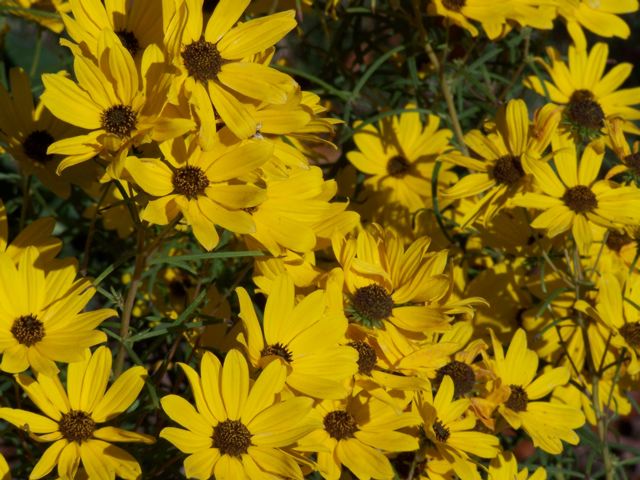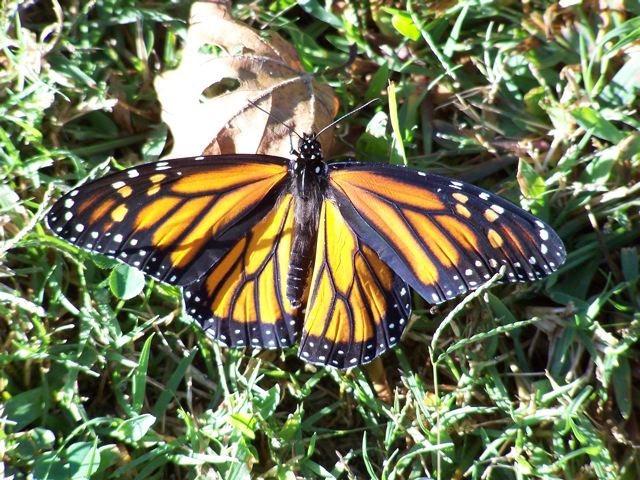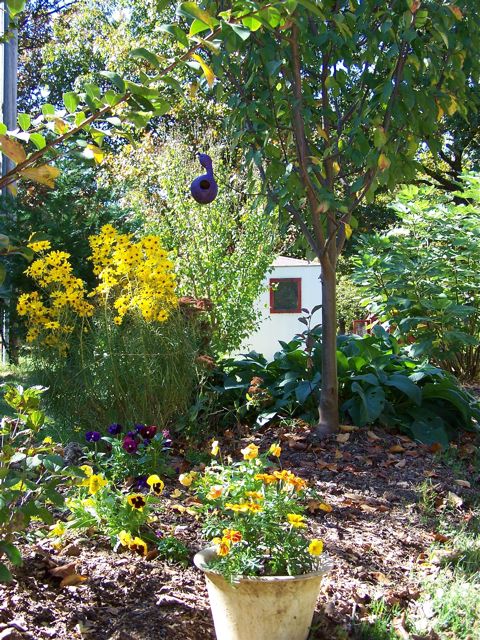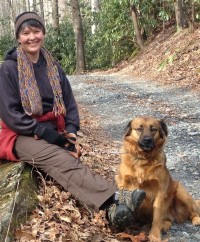What a difference two weeks makes…
Still on the subject of time, I look around today at the thinning leaves on the branches, the sea of copper oak leaves on the grass, and I can’t believe that just about two weeks ago it looked like the pictures below.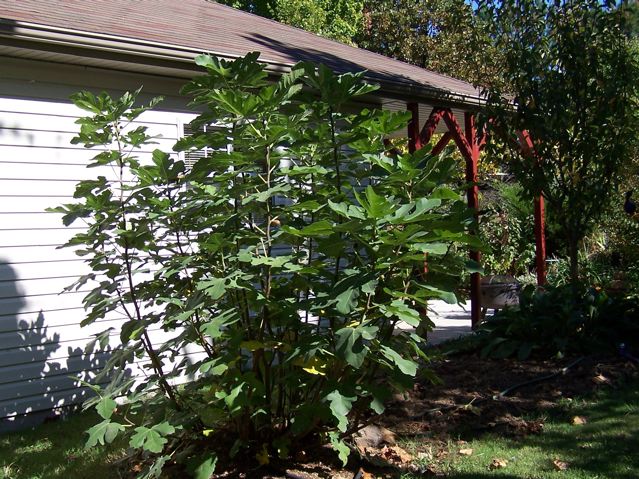
The fig tree made it up pretty big this year! As I’ve said before, being from Alabama where figs really grow into tree sized, this still seems like a fig bush to me.
It’s a brown turkey fig tree (bush) and this year for the first time we had several handfuls of delicious figs. Incredibly, this hot spot against the south facing wall is still a little too shaded by a neighboring sycamore tree to bear fully. The figs don’t really ripen till October. By that time the sun has dropped low enough for the sycamore to cast shade. Hmmm. I’d like to plant another higher on the property to get *more* sun. Amazing that the Arkansas Ozark sun is still not quite enough for these guys!
This narrow leaf sunflower was a beauty this year.
This was one of the last monarchs to emerge. This was his first hour of morning sunshine. His wings were still soft. I hope he caught a strong tailwind and made it down to warmer climes before the first frost we had on October 25th or so.
So it will be many months till it looks like this again. But there’s plenty to do, designing, reading and dreaming of the garden 2009! Thanks for stopping by Larrapin for a look back to two weeks ago. The next post will be a Buckeye update!
Read MoreWhere does the time go?
 |
My Grandmother always said time speeded up when you got older. I guess I thought she meant when I got her age, not my age now! Autumn is here in all her glory. The leaves are full of color and falling on every breeze. This purple birdhouse in the front yard maple looks like a postcard for Autumn to me. Of course it is Arkansas, so I’m out messing around in the garden every day, getting beds cleaned out and covering them with a deep coat of chopped leaves. Ahhh, back to the chopped leaves.
You see for the first time ever, this year I was on the ball enough to plant a cover crop. A lovely cover crop, the “soil-builder” mix from Peaceful Valley Farm Supply. It came up and got about six inches high. Looked completely lovely, like it was doing fabulous things to the soil right before my eyes. Then killer-bambi descended.
We are having deer trouble for the first time in ten years of gardening in two states surrounded by deer. Our big dog Shug is about 13 now. She’s still pretty tough up close – she’s a big chow mix, but her eyesight and hearing have faded enough that she doesn’t see or hear the apparent HERDS of bambi that must march like hungry zombies out of the woods towards the garden while Shug keeps her nearsighted and nearscented watch from the porch many yards away. Ahh, the indignities of old age… Shug would be mortified if she knew there were armies of deer *just* over there in the garden. You can tell them by the crunching…
So anyway, the deer ate the cover crop down to the stubs. Horrors. So I’m back to covering the raised beds with deeps layers of chopped leaves. Not as good for the soil as cover cropping, but the next best thing for me. Sigh… I will get even with killer bambi. I’ve been online and discovered the electric-fence-wire-dabbed-with peanut-butter treatment. Next time I’m at Tractor Supply, a fence charger is on my list. And a big jar of peanut butter. Bambi, prepare for a PB & J (peanut butter & jolt) you won’t forget!
I know this sounds harsh from a person who welcomes (most) wildlife to the garden with open arms. But some wildlife just can’t be good neighbors with the garden. Nevermind there are fields of grass all around that seem fine for cattle. And acres of brushy woods that deer favor. So bambi, please back off a bit. I’ll try the fence and see if that works. It’s not fatal, if a bit startling, no doubt. If that doesn’t work, I may have to sit out in the garden with the shotgun like Ozark gardeners of the past have probably done many a night, protecting the garden, and planning for venison stew!!
Read MoreGrow it and they will come: Monarch butterflies
Wow! These guys can eat! These pictures are from about two weeks ago, when I noticed that there were DOZENS of Monarch butterfly caterpillars on a tropical milkweed out in the veggie garden that had eaten every leaf on the plant. Here’s a video snippet (1 min) of that plant:
So by snipping off the bare branches loaded with baby Monarchs, I relocated them to a milkweed that had plenty of leaves. They crawled off, eating all the way! The lesson here, same as last year: Plant more milkweed! Below are some pics of the relocated caterpillars…
And here is a tiny video (1 min) after the successful relocation:
Postscript to this story: Since the receiving milkweed plant is right beside the front patio, our front porch is now festooned with little leaf-green cocoons dotted with gold. We kept one (which was on a leaf I accidentally plucked) in a jar with a coffee filter over the top, till it emerged and we released the most perfect Monarch into a gorgeous September day.
Fly hard towards Mexico beautiful friends!
Read MoreBuckeyes Play Day in the Big Pen
Are these gals growing up or what? From their hatch date on August 6th they have grown steadily and are starting to look like real pullets!
So on days when we’re home to deep an eye out for hawks (since these gals are the the perfect hawk-bait size right now) they get to romp with the big chickens for the day. After we’ve put the big rooster, Red, outside the pen, that is. Red has to go to a new home soon (or the soup pot…) He was a rooster that arrived as packing material with our guinea chicks. He’s a handsome Americauna, but that’s not what we raise around here now…

Here’s everybody on the chick room doorstep. The love to scratch away the straw and take dust baths already.

These girls are serious hunters already.
The Buckeyes are supposed to be a deep red brown (like a Buckeye nut) and some of these are getting a nice deep color. Others are still pretty light. Eventually, we’ll select for the good color and good egg production.
Thanks for stopping by Larrapin Garden! Things have been so busy with work and life I’ve had no time to post, but will give a monarch butterfly update soon.
(Yikes, I had to re-publish this post till I got the pics right. Usually I use Flickr, but was trying to use Blogger images. Tricky! I didn’t know you had to choose, it seems between pics 400px wide OR 640 pics wide, OR, they don’t show up! Live & Learn…may be going back to Flickr pics…)
Read MoreBuckeye Chick Update – 1 Month
So, the Buckeye chicks are a month old! In a previous post I described getting the day-old chicks. Now here they are, about five times the size they arrived (at least!) —
The red ones are Buckeys, the black ones are Australorps, both will grow up to be brown egg layers. I picked th Australorps, I confess, because I love a glossy black chicken from a photography/aesthetic point of view. Plus I have an old black hen of unknown origin who is my favorite… The Australorps, I read, are a friendly docile chicken. Someone forgot to tell my batch this as they are a shy, flighty bunch with one striking exception of a little gal who will follow you like a pup. But maybe they are only flighty when compared to my beloved little Buckeyes, who are basically fearless.
The Buckeye is the only U.S. chicken breed developed by a woman. Hattie Metcalf of Ohio developed the breed in the 1800s to be dual purpose (meat/eggs), vigorous free rangers, friendly personality and very cold hardy. While the last part isn’t so critical in Arkansas as in Ohio, the personality (friendly, fearless, hate mice and make unusual sounds!) and free-range foraging traits perked up my interest.
I first read about them on the American Livestock Breeds Conservancy “critical” list of varieties of chickens of which there are 500 or fewer birds, or less than five breeding flocks (50 birds) in the U.S. The Buckeye was on their priority list to preserve and the traits were enough for me to say THAT’s the chicken to take on as a Larrapin farm project! (ALBC’s Buckeye page)
Maintaining the genetic heritage of these livestock breeds as we go into the future is a part of sustainable living in my opinion. Our ancestors couldn’t depend factory-grown chickens (can we? should we? I won’t buy the stuff after living here in their chicken raising part of the world and seeing how industrial birds are raised…) so farmers of the past developed breeds that could live in the real world, in specific locales. That is a genetic heritage we don’t want to lose, given the uncertainty of the future…ok, stepping down off the soap box…
So my first group of 12 chicks arrived from Ideal Hatchery out of Texas, all pullets, with their Australorp friends. Of the twelve I’ll pick the best hens to keep and then gradually add to my flock while selecting for egg productions. Washington County Fair, poultry division, here I come!
But first, we had to make a bigger home for these gals because at a month old, they outgrew their 4 x 8′ playpen. We took one bay of the chicken shed and closed it in and set it up as their new playROOM. (Our place came with three open sheds in the three little pastures because the former owner raised emus)
We were taking a break from building the door and front of the shed when I snapped this pic. We’d locked the other chickens out so they wouldn’t get in the way or get too curious about the babies (which might not be safe for 1 month old chicks who are strangers to my old flock…). I love how the old girls are waiting outside the gate like, hey, why are we out here!?
It didn’t take too long to build a sturdy door and front with hardware cloth. Can’t use chicken wire because raccoons are notorious for reaching through and pulling out chickens piece by piece! Yikes. So we have 1/2 inch mesh heavy duty hardware cloth on the front. We also wrapped the back of the shed in it. The old boards are falling apart and until I can replace them, we did a wire overwrap… Here’s our new door with babies happily in their spacious playroom:
They love it! Finally, if you’d like to see these cute one-month olds romp in their new digs on a one minute video snippet, press the “play” arrow below:
For you folks outside the city limits, check out the ALBC’s list of rare heritage livestock in need of conservation. You may find your next barnyard friends and be doing a good thing too.
Thanks for stopping by Larrapin.
Read More





